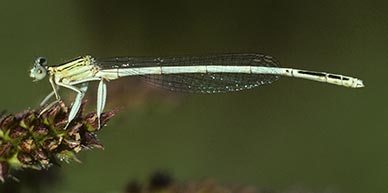White-legged Damselfly (Platycnemis pennipes)
When: Late May to mid- August
How many: Very scarce in most locations

White-legged Damselflies are a New Forest enigma. Dainty creatures, quite scarce nationally and with a primarily southerly UK distribution, they are rarely seen in the New Forest. In fact, a half mile stretch of Ober Water a little upstream from Puttles Bridge - which carries the Rhinefield Road over the stream to the west of Brockenhurst - is probably the only location where they can regularly be observed.
And therein lies the puzzle, for this section of stream features shallow water with a mixture of sunlight and shade, a slow flow over heathland and a channel that is narrow, well-vegetated and in places gravel bottomed; a set of characteristics that seem common to a number of other local streams that are systematically shunned by these insects.
Why, then, the absence elsewhere? Maybe the other superficially similar streams once held colonies that long ago died out as a result of pollution or habitat change, maybe the insects’ capacity for dispersal and recolonisation is weak or maybe the damselflies see something that is particularly attractive in Ober Water and / or its adjacent landscape that is not present elsewhere. (To add to the mystery, in other parts of the UK, mud on the stream bed is usually preferred to gravel).
But whatever the reason for large scale absence, rarity status means that White-legged Damselfly sightings are always welcomed by enthusiasts.
Of delicate appearance, White-legged Damselflies have a wingspan of around 4 centimetres and are a mere 3.5 centimetres in length. Colouration is predominantly cream to pale blue or green with a black line running along the top of the abdomen which, in males, widens into a broad black band over the last four segments. The legs, as the name suggests, are of a distinctively pale hue, but with a black line present. Look out, too, for the noticeably swollen tibia - the middle section of the leg.
On the wing from late May to mid-August, these damselflies are typically most abundant around late June. Mating is usually preceded by a courtship display flight performed by the male, a flight similar to that employed when attempting to deter the presence of, or drive away, competitors.
References:
A Guide to the Dragonflies of Great Britain: Dan Powell
Dragonflies and Damselflies of Britain and Northern Europe: Bob Gibbons
The Dragonflies of Hampshire - John Taverner, Steve Cham, Alan Hold, et al
More links
Other related links
Search this site

Sadly, 58 animals were killed - 35 ponies, 13 cows, 8 donkeys and 2 sheep, whilst a further 32 were injured - 3 pigs, 9 donkeys, 11 cows and 9 ponies.
(Forty-three accidents occurred in daylight, 15 at twilight and 101 in the dark. Twenty-seven accidents were not reported by the driver involved).
Here's just one horrific example - Three donkeys killed in collision with van at notorious New Forest blackspot (Advertiser and Times)

